Country guides

Things to do in Nepal
Home to eight of the world's highest peaks, Nepal is a mountaineer's dream. Most tourists begin journeys in the bustling capital of Kathmandu, soon making their way to the Himalayas. Whether exploring the Annapurna, Langrang, or Everest regions, trekkers will encounter turquoise lakes, mountain villages, and lush valleys with snowy titans towering above.
Visitors will have no problem finding treks that suit their level of experience and budget. Hikers lighten their loads on 'teahouse treks' by relying on teahouses for food and accommodation, with both casual and veteran mountaineers equally captivated by the country's majesty.
Travellers can further take advantage of the country's diverse natural beauty by embarking on white water rafting trips or exploring the jungles of the southern Tarai belt, seeking sightings of Bengal tigers from the back of an elephant.
With countless shrines and temples scattered across the county, Nepal's spiritual and religious heritage attracts numerous pilgrims. Travellers can visit Pashupatinath, one of the world's largest Hindu temples dedicated to Shiva, and step back in at the ancient royal cities of Patan and Bhaktapur.
The UNESCO World Heritage site at Lumbini is seen as the birthplace of the Buddha while the 5th-century Swayambhu Stupa is one of the most sacred Buddhist sites in the country, with prayer flags fluttering from its golden spire.
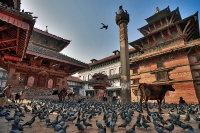
Durbar Square
Protected as a UNESCO World Heritage Site, Durbar Square is the religious and social heart of Kathmandu's old city. Built between the 12th and 18th centuries by the ancient kings o…
Durbar Square
Protected as a UNESCO World Heritage Site, Durbar Square is the religious and social heart of Kathmandu's old city. Built between the 12th and 18th centuries by the ancient kings of Nepal, it's a complex of palaces, temples, shrines, statues, and courtyards. The square is a queer assortment of the old and the new, its elaborately carved architectural features and curving roofs providing shelter for cows and weary tourists. Brahman priests and painted sadhus perform rituals and pose for photos, while souvenir sellers and rickshaw drivers compete for attention among the crowds. Stone lions guard the gates to the Old Royal Palace, which contains a number of courtyards and houses the Narayanhity Durbar Museum. Set into the palace wall is a 17th-century stone inscription written in 15 languages. It's believed milk will flow from the spout if anyone deciphers the entire inscription.
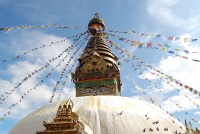
Swayambhunath Stupa
Colourful fluttering prayer flags adorns the golden spire of the 5th-century Swayambhu Stupa. It crowns a hill overlooking the Kathmandu Valley and offers fantastic views over the …
Swayambhunath Stupa
Colourful fluttering prayer flags adorns the golden spire of the 5th-century Swayambhu Stupa. It crowns a hill overlooking the Kathmandu Valley and offers fantastic views over the capital city of Kathmandu. The Swayambhunath Stupa is one of the most recognisable symbols in Nepal, with the painted eyes of the Buddha watching all those who ascend the worn stone steps. A UNESCO World Heritage Site, it is one of the holiest Buddhist sites in Nepal and is at the source of the valley's mythical beginning. Legend has it that the history of the valley began with the draining of an ancient lake by an Enlightened Being, when a lotus flower was transformed into the hill and the shining light became the stupa itself. Also called the Monkey Temple, swarms of pilgrims and red-clad monks circle the complex, spinning the prayer wheels while scores of monkeys that give the temple its nickname prance about in irreverent troupes. The temple complex is scattered with shrines and statues of Buddhist and Hindu deities, and the assortment of pilgrims from both faiths characterises the country's unique religious harmony. Visitors should note that although they are often adorable and entertaining, the monkeys can sometimes become aggressive if visitors have something they want.
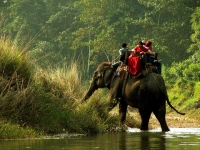
Royal Chitwan National Park
Of the 14 national parks and reserves in Nepal, the Royal Chitwan National Park is the oldest and most popular safari destination for visitors. Situated in the subtropical Tarai lo…
Royal Chitwan National Park
Of the 14 national parks and reserves in Nepal, the Royal Chitwan National Park is the oldest and most popular safari destination for visitors. Situated in the subtropical Tarai lowlands, the jungle is home to endangered animals such as the one-horned rhinoceros and the royal Bengal tiger. Other animals include leopards, wild elephants, Indian bison, sloth bears, crocodiles, pythons, monitor lizards, pangolins, and over 400 species of birds. The terrain is mostly flat, consisting of dense jungle, marsh, and grassland. There's no guarantee of good game sightings, so it is best to spend at least two days in the park. Elephant safaris are the most popular way to explore the park. Jeep safaris, guided walks, overnight jungle expeditions, and canoe trips are also available. There is a wide choice of accommodation, ranging from luxury camps or hotels within the park to budget options on the outskirts. The best place to look for budget accommodation is Sauraha, becoming something of a tourist centre with hotels, restaurants, bars, travel agents, money changing facilities, shops, and even internet cafes. The town has a beautiful setting, sitting on the banks of a wide river in the jungle.
Website www.chitwannationalpark.gov.np
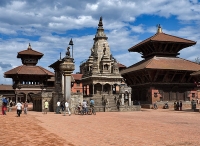
Bhaktapur
Also known as the City of Devotees, Bhaktapur lies just 22 miles (35km) east of Kathmandu. The wealth of fabulous architectural showpieces, soaring pagodas, richly ornamented house…
Bhaktapur
Also known as the City of Devotees, Bhaktapur lies just 22 miles (35km) east of Kathmandu. The wealth of fabulous architectural showpieces, soaring pagodas, richly ornamented houses, and medieval layout is testament to the period when the city was the capital of the Kathmandu Valley during the 14th and 16th centuries. The whole town is a UNESCO World Heritage Site filled with palaces, temples, statues, and squares, connected by a maze of largely pedestrian streets. The main Durbar Square boasts many architectural attractions, including the Golden Gate, the 15th-century Palace of 55 Windows, and several statues of ancient kings. Taumadhi Square is presided over by the elegant Nyatapola Temple. Sitting atop a five-story platform, Nyatpola is the tallest pagoda temple in the Kathmandu Valley. Bhaktapur is also the centre of traditional pottery and weaving industries in the region. Visiting Bhaktapur is like stepping back in time, with its largely preserved ancient traditions, frequent colourful festivals and a meticulously restored cityscape. Visitors to this magnificent ancient city are required to pay a fairly steep entry fee, after which it's possible to stay in the city for up to a week.
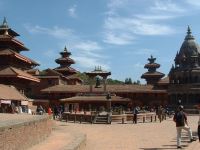
Patan
Officially called Lalitpur Metropolitan City, Patan is one of the three royal cities in the Kathmandu Valley. It has a rich cultural heritage and is known for its fine crafts, evid…
Patan
Officially called Lalitpur Metropolitan City, Patan is one of the three royal cities in the Kathmandu Valley. It has a rich cultural heritage and is known for its fine crafts, evident in the elaborate architecture, stone carvings, and metal statues found all over the city. Patan is actually one of the biggest cities in Nepal, with historic attractions mostly located near Durbar Square and best explored on foot. Patan Durbar Square is a good place to see beautiful examples of palaces, temples, and shrines, and stunning stone carvings of the Sundari Courtyards. The entire city of Patan was designated a UNESCO World Heritage Site in 1979 and is a centre of both Buddhist and Hindu culture in Nepal. Patan is home to more than 1,200 monuments, so tourists are spoilt for choice. One of the most stunning sites is the Krishna Mandir, a stone temple with magnificent friezes built in the 16th century. Other amazing temples include the Mahaboudha Temple, the Rudravarna Mahavihar, the Machchhendranath Temple, the Golden Temple, and the Kumbheshwar Temple. The Patan Museum is also a very popular tourist attraction.
Admission
Patan Durbar Square NPR 500, Patan Museum NPR 250
Pashupatinath Temple
One of the most sacred Hindu shrines in the world, the UNESCO World Heritage Site of Pashupatinath is one of the major temples devoted to Lord Shiva on the Indian subcontinent. It …
Pashupatinath Temple
One of the most sacred Hindu shrines in the world, the UNESCO World Heritage Site of Pashupatinath is one of the major temples devoted to Lord Shiva on the Indian subcontinent. It attracts thousands of Hindu pilgrims each year, with Shiva being the patron deity of Nepal. The Temple of Pashupatinath is renowned for its beautiful architecture and stands on the banks of the holy Bagmati River, a tributary of the Ganges. Other temples, shrines, statues, and pagods surrounded this large temple complex, which can take some time to explore. The temple buildings are closed to non-Hindu visitors but the grounds are not. Shiva devotees and holy Hindi ascetics called sadhus roam the complex in great numbers, meditating and praying on the steps throughout the temple. One of the richest temples in Nepal, it received a great deal of wealth from kings and aristocrats in devotion to the god. The complex is also home to Kathmandu's funeral ghats, a series of cremation platforms spread along the river where the bodies of Hindus are burnt and the ashes scattered into the holy river. Tourists should be respectful when witnessing these cremation ceremonies and particularly cautious about taking photographs.
Annapurna Region
The most popular region for trekking in Nepal, the Annapurna region passes through some of the most spectacular scenery in the country. It has deep valleys, ancient stone settlemen…
Annapurna Region
The most popular region for trekking in Nepal, the Annapurna region passes through some of the most spectacular scenery in the country. It has deep valleys, ancient stone settlements, Tibetan culture, Buddhist temples and monasteries, and mountains over 22,966 feet (7,000m) tall. Excellent lodges line the main routes of the Annapurna Circuit, the Annapurna Sanctuary, and the Jomsom trek to Muktinath. The Annapurna Circuit is one of the most walked treks in the country and is one of the most exceptional routes on earth, crossing Thorong-La pass at 17,769 feet (5,416m) and requiring about three weeks to complete. The Sanctuary requires about 10 days and is a direct route straight to the heart of the Himalayas, where tremendous sheer-walled peaks of 19,685 to 26,247 feet (6,000 to 8,000m) encircle the reverent trekker at the Annapurna Base Camp. Easily accessible via a short flight from Pokhara or Kathmandu, Jomsom is a town situated between two gigantic mountains in the Kali Gandaki Valley, at the bottom of the world's deepest gorge. From Jomsom, there are options to walk in either direction along the Annapurna Circuit. The trek to the holy shrine at Muktinath is very popular and follows the ancient trade and pilgrimage route across the Himalayas.
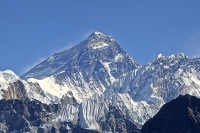
Mount Everest Region
The sight and challenge of the highest mountain the world draws trekkers and mountaineers from across the world. They set out to explore the Sagarmartha National Park in the northe…
Mount Everest Region
The sight and challenge of the highest mountain the world draws trekkers and mountaineers from across the world. They set out to explore the Sagarmartha National Park in the northeast of Nepal, even if not attempting an ascent. The Sagarmartha National Park is a UNESCO World Heritage Site, containing a mixed terrain of deep gorges, glaciers, and rocky landscapes. Home to some interesting fauna and flora, the alpine vegetation nevertheless gives way to bare rock and snow as the altitude increases. Most trekkers fly to the airstrip at Lukla at an altitude of 9,350 feet (2,850m) from where the trek begins to Everest Base Camp. From Lukla, the trail winds up the Dudhkoshi River Valley to the famous Sherpa village of Namche Bazaar. Above Namche, travellers will find the smaller traditional villages of Khunde and Khumjung, and across the canyon from Khunde is the fascinating Tengboche Monastery, one of the highlights of the area. Visitors will find lodges and campsites at the monastery. By flying in and out, the trek requires about two weeks. It's also possible to walk in but this requires much more time. Multi-day treks in the region are a wonderful opportunity to observe and participate in the daily life of the Sherpa people, and of course, the views and landscapes are breath-taking.


